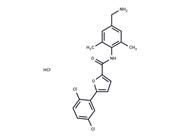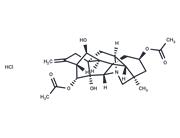| Name | SAG hydrochloride (912545-86-9(free base)) |
| Description | SAG hydrochloride (912545-86-9(free base)) (Smoothened Agonist HCl) acts as an SMO agonist. |
| Animal Research | Animal Models: RatFormulation: DMSODosages: 2.5 nMAdministration: Intracerebroventricular administration(Only for Reference) |
| In vitro | SAG regulates Smo activity by binding directly to the Smo heptahelical bundle. [1] SAG induces Smo-dependent signaling through Gli in a GRK2-dependent way. [2] SAG also (1 nM) induces proliferation of neuronal and glial precursors without affecting the differentiation pattern of newly produced cells. |
| In vivo | In the adult rat hippocampus, the intracerebroventricular administration of SAG (2.5 nM) significantly increases the number of newly generated cells and extends survival of hippocampal cells. [3] In mice, SAG (20 μg/g, i.p.) effectively prevents GC-induced neonatal cerebellar developmental abnormalities. |
| Storage | Powder: -20°C for 3 years | In solvent: -80°C for 1 year | Shipping with blue ice/Shipping at ambient temperature. |
| Solubility Information | Ethanol : 38 mg/mL (72.17 mM), Sonication is recommended.
DMSO : 66 mg/mL (125.35 mM), Sonication is recommended.
10% DMSO+40% PEG300+5% Tween 80+45% Saline : 2 mg/mL (3.8 mM), Sonication is recommended.
|
| Keywords | Smoothened | SAG hydrochloride (912545-86-9(free base)) | SAG hydrochloride (912545869(free base)) | SAG hydrochloride (912545 86 9(free base)) | Hedgehog/Smoothened | Hedgehog |
| Inhibitors Related | Itraconazole | Naftifine hydrochloride | IHR-1 | GANT 61 | ALLO-2 | Ellagic acid | Triparanol | Vismodegib | Halcinonide | MRT-83 | Tolnaftate | Sonidegib |
| Related Compound Libraries | Osteogenesis Compound Library | Reprogramming Compound Library | Anti-Pancreatic Cancer Compound Library | Bioactive Compound Library | Cancer Cell Differentiation Compound Library | Membrane Protein-targeted Compound Library | NO PAINS Compound Library | Bioactive Compounds Library Max | GPCR Compound Library | Anti-Cancer Compound Library | Wnt/Hedgehog/Notch Compound Library | Neuronal Differentiation Compound Library |

 United States
United States






